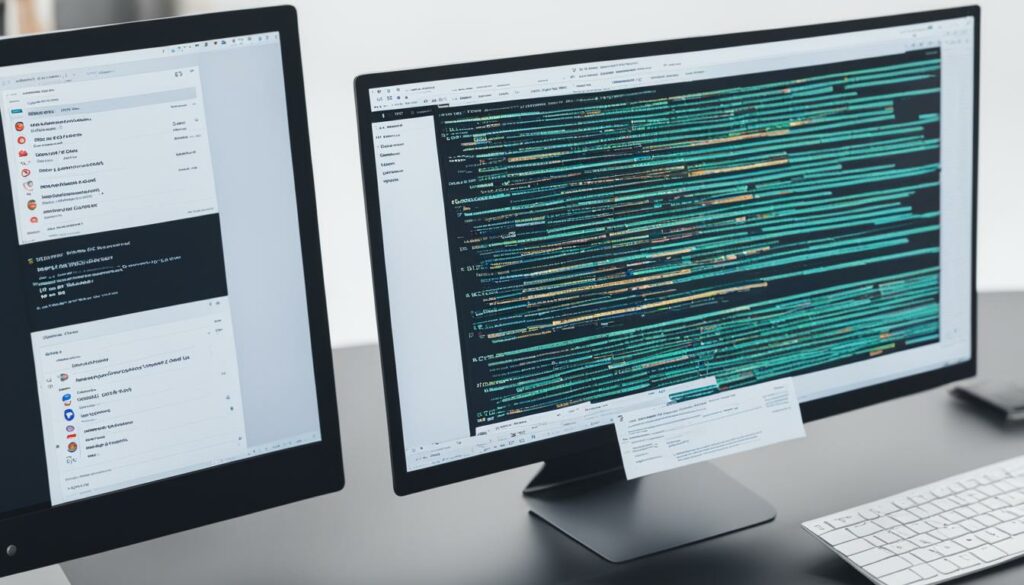Are you interested in becoming a full-stack developer? Wondering what skills are required for this exciting role? In this article, we will explore the essential skills and job requirements to help you embark on your journey to becoming a full-stack developer.
A full-stack developer is responsible for developing both the front end and back end of web applications. They possess a range of skills to handle various aspects of web development. These skills include:
- Knowledge of front-end languages like HTML, CSS, and JavaScript
- Proficiency in backend technologies like JavaScript (Node.js) and Java
- Understanding of database management systems like MySQL and MongoDB
- Familiarity with version control systems like Git and GitHub
- Ability to work with web hosting platforms like Amazon Web Services and Google Cloud Platform
With these skills, you will be well-equipped to tackle the challenges of full-stack development and create robust and dynamic web applications.
Key Takeaways:
- Full-stack developers are responsible for both the front end and back end of web applications.
- Their skills include proficiency in HTML, CSS, JavaScript, backend technologies like JavaScript (Node.js) and Java, and database management systems like MySQL and MongoDB.
- Version control systems like Git and GitHub are essential tools for full-stack developers.
- Web hosting platforms like Amazon Web Services and Google Cloud Platform are commonly used by full-stack developers.
- By acquiring these skills, you can embark on a successful career as a full-stack developer and contribute to the thriving field of web development.
What is Full Stack Web Development?
Full-stack web development encompasses the creation of both the front end and back end of a website or web application. In this process, front-end development focuses on the visual elements that users can see and interact with, such as images, graphics, and layouts. Back-end development, on the other hand, deals with the server-side of the website that users cannot see, which includes tasks like database management, code building, and API development.
Full stack developers are skilled in both front-end and back-end development, allowing them to create dynamic and attractive websites that offer a seamless user experience.
Front-end development is responsible for the aesthetics and user interface of the website, ensuring that it is visually appealing and easy to navigate. This involves working with HTML, CSS, and JavaScript to create responsive designs and interactive features that engage users.
Back-end development, on the other hand, focuses on the functionality and logic of the website. It involves tasks like database management, server-side scripting, and API integration, all of which ensure that the website operates smoothly and efficiently.
Full-stack web development combines the skills and knowledge required for both front-end and back-end development, allowing developers to create websites that are both visually appealing and highly functional. With the ability to handle every aspect of the development process, full stack developers are in high demand and play a crucial role in the field of web development.
Next, let’s delve deeper into the specifics of front-end web development and the skills required in this aspect of full-stack development.
Frontend Web Development
Frontend web development plays a crucial role in creating the user interface of a web application. It focuses on designing an attractive and user-friendly interface that enhances the overall user experience. To achieve this, frontend developers utilize HTML, CSS, and JavaScript to structure and style the content and elements of a webpage.
HTML, or Hypertext Markup Language, is the backbone of web development. It provides the foundation for organizing and structuring the content within a webpage. By using HTML tags, developers can define headings, paragraphs, lists, images, and other elements that make up the structure of a webpage.
CSS, or Cascading Style Sheets, brings life to the structure created by HTML. It allows developers to customize the appearance of a webpage by defining styles, colors, layouts, and typography. With CSS, developers can create visually appealing designs and ensure consistency throughout the entire website.
JavaScript, a powerful programming language, adds interactivity and dynamic features to a webpage. It enables developers to create interactive forms, implement animations, handle user events, and fetch data from external sources. JavaScript enhances the user experience by making websites more engaging and responsive.
Frontend web development merges the artistic aspects of design with the technical implementation of coding, resulting in visually appealing and user-friendly interfaces. It requires a good understanding of HTML, CSS, and JavaScript to ensure seamless navigation, optimized performance, and an intuitive user experience.

Backend Web Development
Backend web development involves the creation of the server-side functionality of a website or application. This aspect of development focuses on making the website interactive and handling tasks such as database management, debugging, and API development.
Backend developers utilize various programming languages to build the core functionality of a web application. Examples of programming languages commonly used in backend development include JavaScript (Node.js), Java, Python, C#, PHP, Perl, and Ruby. These languages enable developers to create robust and dynamic backend systems that ensure the smooth functioning of websites.
One of the main responsibilities of backend developers is database management. They work with database management systems to store, retrieve, and manipulate data, ensuring efficient and secure data management. Additionally, backend developers play a crucial role in debugging and troubleshooting issues that may arise on the server-side of the application.
Quote: “Backend development is like the backbone of a website. It provides the necessary functionality that supports the frontend and makes the entire application come to life.” – Jane Smith, Senior Backend Developer.
Backend web development also encompasses the development of APIs (Application Programming Interfaces) that facilitate data exchange between different components of a website or application. By creating well-designed APIs, backend developers enable seamless integration of various functionalities and services.
Moreover, backend developers focus on ensuring scalability and security of web applications. They design and implement efficient architectures that allow websites to handle increasing amounts of traffic and data. By incorporating security measures, backend developers protect sensitive information and mitigate the risk of data breaches.
Quote: “Backend developers are the unsung heroes of web development, working behind the scenes to ensure the smooth running of websites and applications.” – John Davis, Lead Backend Developer.
In conclusion, backend web development is a vital aspect of web application development. From handling database management to creating APIs and ensuring scalability and security, backend developers play a crucial role in bringing websites and applications to life.
Key Skills of a Full Stack Developer
A full stack developer must possess a diverse set of skills to excel in their role. They are responsible for handling both frontend and backend development tasks, database management, version control, and web hosting. To become a successful full stack developer, you need to acquire the following key skills:
Frontend Languages
Proficiency in frontend languages like HTML, CSS, and JavaScript is crucial. HTML is used to structure the content of webpages, CSS is employed for styling and customizing the appearance, while JavaScript enables interactivity and enhanced user experience.
Backend Technologies
A full stack developer should have knowledge of backend technologies such as Node.js, Java, and Python. These languages empower developers to build the core functionality of web applications and handle server-side processes.
Database Management
Understanding database management systems is vital for a full stack developer. You should be familiar with databases like MySQL and MongoDB to effectively manage and manipulate data within web applications.
Version Control
Version control is essential for efficient collaboration and code management. Proficiency in version control systems like Git and GitHub is necessary for tracking changes, branching, merging code, and ensuring the stability of web projects.
Web Hosting
Full stack developers should possess the ability to work with web hosting platforms such as Amazon Web Services and Google Cloud Platform. This involves deploying and managing web applications, configuring server environments, and ensuring optimal performance and scalability.
“Mastering these key skills equips you with the knowledge and capabilities to excel in the field of full stack development.”
By acquiring these skills, you will have a solid foundation to tackle the challenges and complexities of full stack development, ensuring the successful creation and deployment of robust web applications.
Responsibilities of a Full Stack Developer
As a full stack developer, you have a wide range of responsibilities when it comes to web application development. Your role encompasses both front-end and back-end development, along with various other tasks. Let’s delve into the key responsibilities that define the role of a full stack developer:
Front-End Development
Front-end development involves designing the user interface and building interactive user experiences that engage and delight users. You’ll use your expertise in HTML, CSS, and JavaScript to create visually appealing interfaces and ensure the smooth functioning of the front-end components. With your skills, you’ll craft seamless navigation, captivating layouts, and eye-catching visuals that bring websites to life.
Back-End Development
Back-end development is focused on creating a robust framework and architecture for the server-side of a web application. You’ll leverage your knowledge of database management systems and server technologies to ensure efficient data storage, retrieval, and manipulation. Working with programming languages like JavaScript (Node.js), Java, or Python, you’ll build the core functionality of the application and handle tasks such as server management and API development.
Cross-Platform Compatibility
Ensuring cross-platform compatibility is a crucial responsibility of a full stack developer. You’ll need to develop applications that work seamlessly across different devices, operating systems, and web browsers. By writing clean and standardized code, you’ll optimize the user experience and ensure that the application functions flawlessly, regardless of the platform.
Database Management
Efficiently managing databases is another vital role of a full stack developer. You’ll be responsible for designing and maintaining databases, ensuring data integrity, security, and scalability. By using database management systems like MySQL or MongoDB, you’ll organize and retrieve data, implement efficient query methods, and optimize performance.
API Development
API (Application Programming Interface) development is a key responsibility for full stack developers. You’ll create APIs that enable seamless communication between different software components, allowing them to exchange data and functionality. With your expertise in API design and implementation, you’ll integrate various services and functionalities into the application, enhancing its overall performance and user experience.
Meeting technical and consumer requirements while juggling these responsibilities is essential for a successful full stack developer. By effectively managing the front-end and back-end development, ensuring cross-platform compatibility, handling database management, and focusing on API development, you’ll play a pivotal role in building high-quality web applications.
“A full stack developer is a versatile professional who combines the skills of front-end and back-end development to create fully functional and user-friendly web applications.”
| Responsibilities | Description |
|---|---|
| Front-End Development | Designing user interfaces and building interactive experiences using HTML, CSS, and JavaScript. |
| Back-End Development | Creating a robust server-side architecture, managing databases, and developing APIs. |
| Cross-Platform Compatibility | Ensuring the application works seamlessly across different devices and platforms. |
| Database Management | Designing and maintaining databases, optimizing performance, and implementing data retrieval. |
| API Development | Creating APIs for seamless communication between software components and integrating different functionalities. |
Programming Languages and Tools of Full Stack
As a full stack developer, you’ll need to work with a variety of programming languages and tools to create dynamic web applications. Here are some key languages and tools that are commonly used in full stack development:
Frontend Development:
For frontend development, you’ll primarily use HTML, CSS, and JavaScript. HTML (Hypertext Markup Language) is used to structure the content of webpages, while CSS (Cascading Style Sheets) is used to style and design the visual elements. JavaScript is a powerful programming language that enables interactivity and enhances user experience. Together, these technologies allow you to create visually appealing interfaces and improve user interaction.
Backend Development:
When it comes to backend development, the choice of programming language depends on the project requirements. Some popular backend languages used by full stack developers include:
- Python: Known for its simplicity and readability, Python is widely used for backend development. It offers a variety of frameworks like Django and Flask, which simplifies the development process.
- Java: Java is a versatile language used for a wide range of applications, including backend development. It has a strong ecosystem and supports frameworks like Spring and Hibernate.
- PHP: Often used for web development, PHP is a server-side scripting language that powers popular content management systems like WordPress.
Version Control and Collaboration Tools:
Version control systems like Git and GitHub play a crucial role in full stack development. Git allows you to track changes in your codebase, making collaboration with other developers seamless. GitHub, a popular web-based hosting platform, provides a centralized location for code repositories and facilitates efficient collaboration among team members.
Additional Tools:
In addition to programming languages and version control systems, you’ll also work with various tools that streamline the development process. These tools include:
- Integrated Development Environments (IDEs): IDEs like Visual Studio Code, IntelliJ IDEA, and PyCharm provide a comprehensive environment for writing, debugging, and testing code.
- Package Managers: Tools like npm for JavaScript and pip for Python help manage dependencies and libraries used in your project.
- Command Line Interfaces (CLIs): CLIs are essential for executing commands, running scripts, and automating tasks.
“Working with the right combination of programming languages and tools is crucial for full stack development success.”
By utilizing these programming languages and tools, full stack developers can leverage their capabilities to create robust and visually appealing web applications.
Popular Programming Languages and Tools Used in Full Stack Development
| Language/Tool | Description |
|---|---|
| HTML | Used for structuring web content |
| CSS | Responsible for styling and designing web elements |
| JavaScript | Enable interactivity and enhance user experience |
| Python | Backend language known for simplicity and versatility |
| Java | General-purpose language with a strong ecosystem |
| PHP | Server-side scripting language for web development |
| Git | Version control system for tracking code changes |
| GitHub | Web-based hosting platform for code repositories |
| IDEs | Integrated Development Environments for coding |
| Package Managers | Manage dependencies and libraries used in the project |
| CLIs | Command Line Interfaces for executing commands |
Soft Skills for Full Stack Developers
As a full stack developer, it’s important to not only have technical skills but also possess certain soft skills that contribute to your overall effectiveness in the role.
- Creativity: Full stack developers need to understand project objectives and think creatively to create engaging and user-friendly products.
- Strategic Planning: Effective planning is crucial to ensure smooth design, development, and implementation phases of a project. By strategically planning your approach, you can streamline processes and optimize outcomes.
- Analytical Skills: Analyzing information and making data-driven decisions are key skills for full stack developers. By leveraging analytical skills, you can identify patterns, trends, and insights that inform your development process.
- Problem-Solving Skills: Full stack developers should be adept at predicting and resolving errors. Strong problem-solving skills enable you to identify and address issues efficiently, ensuring optimal performance and user experience.
- Time Management Skills: Efficiently managing your time is essential as a full stack developer. By effectively prioritizing tasks and meeting deadlines, you can ensure timely completion of projects and keep them on track.
Having these soft skills alongside your technical expertise allows you to excel as a full stack developer, delivering high-quality projects that meet both client and user expectations.
Successful Full Stack Development Project Example:
“When working on a recent web application project, I applied my creativity to design an intuitive user interface that aligned with the client’s brand image. Through strategic planning, I organized the development process into manageable tasks, ensuring timely completion. Using my analytical skills, I analyzed user behavior data to optimize the application’s performance and identify areas for improvement. In the testing phase, my problem-solving skills allowed me to quickly address and resolve any bugs or usability issues that arose. By effectively managing my time and adhering to project deadlines, I successfully delivered a robust and user-friendly full stack application.”
Soft Skills Comparison Table
| Soft Skill | Description |
|---|---|
| Creativity | Ability to think innovatively and generate unique ideas to enhance product design and user experience. |
| Strategic Planning | Capacity to plan and organize development processes to achieve project goals efficiently. |
| Analytical Skills | Proficiency in analyzing data and making informed decisions to optimize development outcomes. |
| Problem-Solving Skills | Capability to identify and resolve issues quickly and effectively, ensuring smooth application performance. |
| Time Management Skills | Aptitude for prioritizing tasks, managing deadlines, and completing projects in a timely manner. |
By honing these soft skills alongside your technical abilities, you can become a well-rounded full stack developer who excels in all aspects of web development.

Full Stack Developer vs. Software Engineer
When it comes to web application development, there is a distinction between a full stack developer and a software engineer. While both roles are essential in the software development industry, they have different focuses and responsibilities. Understanding the differences between these roles can help aspiring professionals choose the career path that aligns with their skills and interests.
Roles and Responsibilities
A full stack developer is proficient in both frontend and backend development. They work on all aspects of a web application, from designing the user interface to creating the core functionality. Full stack developers have a deep understanding of frontend languages like HTML, CSS, and JavaScript, as well as backend technologies such as Node.js, Java, or Python. They also handle database management, version control, and web hosting.
On the other hand, a software engineer has a broader role that involves designing, developing, and analyzing software projects. They are responsible for the entire software development life cycle, including requirements gathering, system design, coding, testing, and deployment. Software engineers may specialize in different areas such as mobile app development, data analysis, or artificial intelligence.
“A full stack developer focuses specifically on web application development, while a software engineer has a broader role encompassing various software projects and domains.”
While full stack developers are a subset of software engineers, their focus is primarily on web development. They possess the skills and knowledge to handle both frontend and backend tasks, making them valuable assets for companies looking to build robust and dynamic web applications.
“Understanding the differences between a full stack developer and a software engineer can help individuals determine their career path in the software development industry.”
Conclusion
Becoming a full stack developer requires a diverse set of technical and soft skills. As a full stack developer, you need to be proficient in both frontend and backend web development, with a deep understanding of database management systems, version control systems, and web hosting platforms. Additionally, honing your soft skills such as creativity, strategic planning, analytical thinking, problem-solving, and time management is crucial for success in this field.
By acquiring these skills, you will be well-equipped to embark on a fulfilling career as a full stack developer. The demand for full stack developers is consistently high, given their ability to handle both the client-side and server-side aspects of web development. With your expertise in creating attractive user interfaces and building robust backends, you can contribute to the ever-evolving and thriving field of web development.
In conclusion, becoming a full stack developer opens up a world of opportunities for you to showcase your technical talent, creativity, and problem-solving abilities. Continuously upgrading your skills and staying up-to-date with advancements in web development technologies will not only help you stay competitive but also enable you to make a significant impact in the industry. So, start your journey to becoming a full stack developer today and unlock a rewarding and dynamic career path.
FAQ
What skills are required to become a full-stack developer?
Full stack developers need to be proficient in frontend languages like HTML, CSS, and JavaScript, have knowledge of backend technologies like Node.js, Java, and Python, understand database management systems, version control systems, and web hosting platforms.
What is full stack web development?
Full stack web development refers to the process of developing both the frontend and backend of a website or web application. It encompasses both the visual elements that users interact with and the server-side functionality.
What is frontend web development?
Frontend web development focuses on creating an attractive and user-friendly interface using HTML, CSS, and JavaScript. It involves designing elements like images, layouts, and navigation to ensure a smooth user experience.
What is backend web development?
Backend web development involves handling server-side tasks like database management, debugging, and API development. It utilizes programming languages like Node.js, Java, Python, and more to build the core functionality of a web application.
What are the key skills of a full stack developer?
Key skills of a full stack developer include proficiency in frontend languages, knowledge of backend technologies, understanding of database management systems, familiarity with version control systems, and the ability to work with web hosting platforms.
What are the responsibilities of a full stack developer?
Full stack developers are responsible for both front-end and back-end development, database management, ensuring cross-platform compatibility, and API development. They play a crucial role in meeting technical and consumer requirements in web application development.
What programming languages and tools do full stack developers use?
Full stack developers work with programming languages like HTML, CSS, JavaScript, Node.js, Java, Python, and more, depending on project requirements. They also use tools like Git and GitHub for version control and collaboration with other developers.
What are the soft skills required for full stack developers?
Full stack developers should possess soft skills like creativity, strategic planning, analytical skills, problem-solving skills, and time management skills. These skills help them understand project objectives, make data-driven decisions, and ensure efficient task completion.
What is the difference between a full stack developer and a software engineer?
While a full stack developer focuses on web application development and handles both frontend and backend tasks, a software engineer has a broader role that includes designing, development, and analysis of software projects.
How can I become a full stack developer?
To become a full stack developer, you should acquire the necessary technical skills in frontend and backend development, familiarize yourself with database management systems, version control systems, and web hosting platforms. Additionally, developing soft skills like creativity and problem-solving will help you excel in this role.












